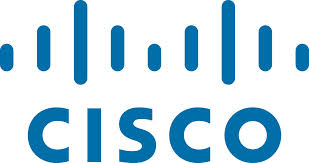There wasn't anything really groundbreaking, and the session was just an hour - and I mean that literally. Cisco makes extensive use of TP internally, and apparently their TP rooms are booked months in advance. So, when your time slot is up, it's up. The screen abruptly went blank on the host in mid-sentence at 1pm on the dot. Gotta keep the train moving I guess.
Most of the talking was done by two key drivers of their collaboration initiatives - Barry O'Sullivan - SVP Voice Technology Group, and Carl Wiese - SVP Global Collaboration Sales. They had a lot to recap from the recent quarter, and here are the main points that I can share:
- they posted 17% year-over-year growth across their collaboration portfolio - UC, contact center, telepresence, IP telephony, WebEx, etc.
- like any vendor in this space, they have been aggressively going after competitors who have struggled, namely Nortel, Siemens and ALU
- while revenues were not disclosed, they cited early successes in their various spaces - 12 customers now using WebEx Mail (all are U.S. and primarily SMB), 450+ are using cloud-based IM, over 3,600 locations using telepresence, and 75 customers using Show and Share
- perhaps the strongest message overall was their move into hosted services - this will now give their customers a choice between premise-based and carrier-based solutions
- highlights were given about 4 recent customer wins - each one showcasing a particular strength of Cisco or attractive market opportunity
- their objective of providing "pervasive video" - both big and small - was briefly discussed, but no updates on the Tandberg deal were given
A couple of these points warrant a bit more detail, so here goes...
Regarding WebEx Mail, that was a highlight for me at their Collaboration Summit last November. They shared one lesson learned with us today, which I found interesting. Their early deployments did not support BlackBerry, and it looks like they underestimated how important this was, even for SMBs. As such, they've had to accelerate BlackBerry integration to keep these deployments moving forward. I asked if they had any indication yet as to whether their email platform has led to faster adoption of other collaboration tools. They liked the question, but didn't have much to say - am guessing it's early days, but I have to think that's the end game here.
The move to hosted has huge implications, and the analysts had lots of questions about this one. I wanted to better understand the role they seek to play, especially in terms of owning the customer and sharing revenues with service providers. They talked about their intent being to get the carrier set up to offer hosted, and then let them run with it. The acronym they used is BOT - "Build, Operate and Transfer". That's the process, and we'll just have to see how it actually unfolds. It's clear they want to have it both ways - deploy on-prem, as well as partner with carriers - with the customer choosing the best path. They wouldn't quantify the market opportunity, but did go so far to say that it "appears real". They're in talks with 10 carriers now, and BT is the one they point to as an announced partner for hosted. There is a lot of potential here for channel conflict, and Cisco is not afraid to tread on new ground. However, I got the sense they are approaching hosted cautiously, and it looked to me like they were choosing their words carefully. Regardless, they're not going to ignore the hosted market, so get used to it, folks.
Two customer wins were of particular interest to me. One was Duke University, where they talked about how they're using telepresence to help extend the classroom experience off campus. I've long felt that distance learning is a huge opportunity, and that IP technologies will play a big role in re-defining higher education.
The other customer win was Molina Healthcare. Aside from this being another great vertical market for collaboration, they cited an interesting outcome from deploying telepresence there. They're finding that people are meeting twice as often, but for half as long. That's a pretty good result, and a great way to validate the value of telepresence.
Finally, I just had to comment on the actual experience of using TP today. Since the topic was collaboration, one would expect the tools for the meeting would properly reflect that. For the most part they did. Even though the screen we used was fairly small - see photos below - both the audio and video quality were very good. However, there was no use of split screens, which would have been effective at times, since Barry and Carl were in different locations. As such, the visuals were very much in a serial manner. One speaker at a time - cut to the next speaker - cut back to the first speaker, etc. I found it a bit like watching a newscast - it's ok, but not that engaging.
Two other small things. I suspect other locations had multiple screens, whereas we only had one. When the host was addressing me, she was looking to the right, which must have been the screen she was seeing me on. This would look perfectly normal from her end, but Andrea and I only saw her looking right, and not at us. This takes some getting used to, as it wasn't clear that she was talking to me. To us, it looked like she was talking to someone else. Live and learn.
The other small thing was the use of a slide deck during the session. They were really just used in passing reference, and most of our attention was centered on the speakers. That was probably for the best, since the slides were only displayed in the bottom right corner of the screen. Since we had a small TP unit, the slides were really small, and almost impossible to read. I'm sure this would be less of a problem on a full-size system, so I guess this comes with the territory. On the other hand, I would have been just as happy to have no slides, which would give us an unobstructed view of the speaker (see photos below). For any speaker sitting on that side of the screen, the slides block out a good portion of their body. While Anderson Cooper would probably roll with that, Ted Baxter would be freaking out - so, as long as the egos are in check, it's probably not a problem. :-)
Barry O'Sullivan

Carl Wiese












2 comments:
Cisco may need new channel partner programs and channel sales strategy to avoid the potential conflict.
Yea we agree. CISCO however, do have an impressive record for channel perfection and managment.
Post a Comment